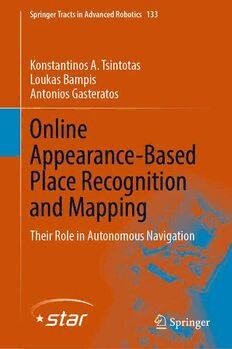
Online Appearance-Based Place Recognition and Mapping: Their Role in Autonomous Navigation PDF
Preview Online Appearance-Based Place Recognition and Mapping: Their Role in Autonomous Navigation
Springer Tracts in Advanced Robotics 133 Konstantinos A. Tsintotas Loukas Bampis Antonios Gasteratos Online Appearance-Based Place Recognition and Mapping Their Role in Autonomous Navigation Springer Tracts in Advanced Robotics Volume 133 SeriesEditors BrunoSiciliano,DipartimentodiIngegneriaElettricaeTecnologie dell’Informazione,UniversitàdegliStudidiNapoliFedericoII,Napoli,Italy OussamaKhatib,ArtificialIntelligenceLaboratory,DepartmentofComputer Science,StanfordUniversity,Stanford,CA,USA AdvisoryEditors NancyAmato,ComputerScience&Engineering,TexasA&MUniversity,College Station,TX,USA OliverBrock,FakultätIV,TUBerlin,Berlin,Germany HermanBruyninckx,KULeuven,Heverlee,Belgium WolframBurgard,InstituteofComputerScience,UniversityofFreiburg,Freiburg, Baden-Württemberg,Germany RajaChatila,ISIR,Pariscedex05,France FrancoisChaumette,IRISA/INRIA,Rennes,Ardennes,France WanKyunChung,RoboticsLaboratory,MechanicalEngineering,POSTECH, Pohang,Korea(Republicof) PeterCorke,QueenslandUniversityofTechnology,Brisbane,QLD,Australia PaoloDario,LEM,ScuolaSuperioreSant’Anna,Pisa,Italy AlessandroDeLuca,DIAGAR,SapienzaUniversitàdiRoma,Roma,Italy RüdigerDillmann,HumanoidsandIntelligenceSystemsLab,KIT-Karlsruher InstitutfürTechnologie,Karlsruhe,Germany KenGoldberg,UniversityofCalifornia,Berkeley,CA,USA JohnHollerbach,SchoolofComputing,UniversityofUtah,SaltLake,UT,USA LydiaE.Kavraki,DepartmentofComputerScience,RiceUniversity,Houston,TX, USA VijayKumar,SchoolofEngineeringandAppliedMechanics,Universityof Pennsylvania,Philadelphia,PA,USA BradleyJ.Nelson,InstituteofRoboticsandIntelligentSystems,ETHZurich, Zürich,Switzerland FrankChongwooPark,MechanicalEngineeringDepartment,SeoulNational University,Seoul,Korea(Republicof) S.E.Salcudean,TheUniversityofBritishColumbia,Vancouver,BC,Canada RolandSiegwart,LEEJ205,ETHZürich,InstituteofRobotics&Autonomous SystemsLab,Zürich,Switzerland GauravS.Sukhatme,DepartmentofComputerScience,UniversityofSouthern California,LosAngeles,CA,USA TheSpringerTractsinAdvancedRobotics(STAR)publishnewdevelopmentsand advances in the fields of robotics research, rapidly and informally but with a high quality. The intent is to cover all the technical contents, applications, and multi- disciplinaryaspectsofrobotics,embeddedinthefieldsofMechanicalEngineering, Computer Science, Electrical Engineering, Mechatronics, Control, and Life Sciences,aswellasthemethodologiesbehindthem.Withinthescopeoftheseries aremonographs,lecturenotes,selectedcontributionsfromspecializedconferences andworkshops,aswellasselectedPhDtheses. Specialoffer:Forallclientswithaprintstandingorderweofferfreeaccesstothe electronicvolumesoftheSeriespublishedinthecurrentyear. IndexedbySCOPUS,DBLP,EICompendex,zbMATH,SCImago. AllbookspublishedintheseriesaresubmittedforconsiderationinWebofScience. · · Konstantinos A. Tsintotas Loukas Bampis Antonios Gasteratos Online Appearance-Based Place Recognition and Mapping Their Role in Autonomous Navigation KonstantinosA.Tsintotas LoukasBampis DepartmentofProductionandManagement DepartmentofElectricalandComputer Engineering Engineering DemocritusUniversityofThrace DemocritusUniversityofThrace Xanthi,Greece Xanthi,Greece AntoniosGasteratos DepartmentofProductionandManagement Engineering DemocritusUniversityofThrace Xanthi,Greece ISSN 1610-7438 ISSN 1610-742X (electronic) SpringerTractsinAdvancedRobotics ISBN 978-3-031-09395-1 ISBN 978-3-031-09396-8 (eBook) https://doi.org/10.1007/978-3-031-09396-8 ©TheEditor(s)(ifapplicable)andTheAuthor(s),underexclusivelicensetoSpringerNature SwitzerlandAG2022 Thisworkissubjecttocopyright.AllrightsaresolelyandexclusivelylicensedbythePublisher,whether thewholeorpartofthematerialisconcerned,specificallytherightsoftranslation,reprinting,reuse ofillustrations,recitation,broadcasting,reproductiononmicrofilmsorinanyotherphysicalway,and transmissionorinformationstorageandretrieval,electronicadaptation,computersoftware,orbysimilar ordissimilarmethodologynowknownorhereafterdeveloped. Theuseofgeneraldescriptivenames,registerednames,trademarks,servicemarks,etc.inthispublication doesnotimply,evenintheabsenceofaspecificstatement,thatsuchnamesareexemptfromtherelevant protectivelawsandregulationsandthereforefreeforgeneraluse. Thepublisher,theauthors,andtheeditorsaresafetoassumethattheadviceandinformationinthisbook arebelievedtobetrueandaccurateatthedateofpublication.Neitherthepublishernortheauthorsor theeditorsgiveawarranty,expressedorimplied,withrespecttothematerialcontainedhereinorforany errorsoromissionsthatmayhavebeenmade.Thepublisherremainsneutralwithregardtojurisdictional claimsinpublishedmapsandinstitutionalaffiliations. ThisSpringerimprintispublishedbytheregisteredcompanySpringerNatureSwitzerlandAG Theregisteredcompanyaddressis:Gewerbestrasse11,6330Cham,Switzerland Betterifitlastsforyears,soyou’reoldbythe timeyoureachIthaka,wealthywithall you’vegainedonyourjourney. —KonstantinosPetrouKavafis,Greekpoet Dedicatedtomybeloved, Oscar 11.9.2009–8.4.2015 Series Editor’s Foreword Atthedawnofthecentury’sthirddecade,roboticsisreachinganelevatedlevelof maturityandcontinuestobenefitfromtheadvancesandinnovationsinitsenabling technologies.Theseallarecontributingtoanunprecedentedefforttobringingrobots to human environment in hospitals and homes, factories, and schools; in the field for robots fighting fires, making goods and products, picking fruits, and watering the farmland, saving time and lives. Robots today hold the promise for making a considerable impact in a wide range of real-world applications from industrial manufacturingtohealthcare,transportation,andexplorationofthedeepspaceand sea.Tomorrow,robotswillbecomepervasiveandtouchuponmanyaspectsofmodern life. TheSpringerTractsinAdvancedRobotics(STAR)isdevotedtobringingtothe research community the latest advances in the robotics field on the basis of their significanceandquality.Throughawideandtimelydisseminationofcriticalresearch developmentsinrobotics,ourobjectivewiththisseriesistopromotemoreexchanges andcollaborationsamongtheresearchersinthecommunityandcontributetofurther advancementsinthisrapidlygrowingfield. ThemonographbyKonstantinosTsintotas,LoukasBampis,andAntoniosGaster- atosisbasedonthefirstauthor’sdoctoralthesis.Thecontentsarefocusedonefficient robotnavigationmethodsprovidinghighperformanceunderrun-timeandmemory constraints. Several appearance-based place recognition pipelines are introduced whicharebasedonthreedifferentmappingtechniquesforaddressingloop-closure detection in mobile platforms with limited computational resources. Remarkably, open-source implementations are made publicly available, intending to serve as a benchmarkfortheresearchcommunity. Richofexamplesdevelopedbymeansofextensiveexperimentationinarangeof challengingscenarios,thisvolumeisaveryfineadditiontotheSTARseries! Naples,Italy BrunoSiciliano June2022 STAREditor ix Preface Withagrowingdemandforautonomousrobotsinawiderangeofapplications,such assearchandrescue,space,andunderwaterexplorations,accuratenavigationismore than necessary for an intelligent system to accomplish its assigned tasks. Simul- taneous localization and mapping (SLAM), i.e., a robot’s ability to incrementally constructamapofitsworkingenvironmentandsubsequentlyestimateitsposition in it, has evolved over the last three decades as the core of autonomous naviga- tion,especiallywhenglobalpositioninginformationismissing.Astheimportance of efficient and robust pose estimation is vital for accurate navigation, nowadays, robotics researchers have put a tremendous effort in developing methods to map the world through several exteroceptive sensors; the reason is the usefulness of an appropriaterepresentationofthesurroundingsfortherobottobeabletoperformits tasks.However,giventhesensors’noiseandtheabsenceofpositionmeasurements, eventhemostaccuratestateestimatorsarepronetodriftinevitablyaccumulatedover time.Hence,SLAMneedstoidentifywhentherobotrevisitsapreviouslytraversed locationandthentorecallit.Thus,thesystem’sdrifterroranduncertaintyregarding theestimatedpositionandorientation(pose)canbeboundedandrectified,allowing consistent map generation. This process is widely known as loop-closure detec- tionandisachievedviaaplacerecognitionpipelineresponsibleforassociatingthe incomingsensorydata(query)withthemap(database).Duetotheabove,thepopu- larityofloop-closuredetectioninthelast30yearsisnotsurprisingifweconsider thenotableSLAMevolution. Several techniques were exploited to map the robot’s environment in the early years,suchasrangeandbearingsensors,viz.,lasers,radars,andsonars.However, due to the increased availability of computational power along the late years and the findings of how animals navigate using vision, mapping from optical sensors was pushed ahead. Beyond the sensor’s low cost and its applicability to various mobileplatforms,especiallytheoneswithlimitedcomputationalcapabilities,e.g., UnmannedAerialVehicles(UAVs),themainreasonforcameras’utilizationisrelated to the significant advantage of the rich textural information embedded in images, which effectively capture the environment’s appearance with high distinctiveness. xi xii Preface Notsurprisingly,modernroboticnavigationsystemsarebasedonappearance-based placerecognitionalgorithmstodetectloop-closures. Nevertheless,nowadays,loop-closuredetectionalgorithmshavetoproviderobust navigation for an extended period. Hence, the computational efficiency and the storage requirements are vital factors for recognizing previously visited areas during long-term and large-scale SLAM operations in uncontrolled environments. The motivation behind this Ph.D. dissertation has been the prospect that in many contemporary applications, where computational resources are restricted, efficient methodsareneededthatcanprovidehighperformanceunderrun-timeandmemory constraints.Thus,thisbookintroducesseveralappearance-basedplacerecognition pipelinesbasedondifferentmappingtechniquesforaddressingloop-closuredetec- tioninmobileplatformswithlimitedcomputationalresources.Thebookathandis articulatedintosixchapters. Despite its unique traits, loop-closure detection is a task inextricably related to placerecognition.Therefore,thebookwouldnotbecompleteunlessitbrieflyexam- inesthegeneralconceptofvisualplacerecognitionintheroboticscommunity(see Chap.1).Similarly,abriefintroductiontoSLAMisprovided,whilethedifferences betweenthecommonlyusedtermsoflocalization,re-localization,andloop-closure detectionarealsodistinguishedanddiscussed.Finally,anoverviewofthecurrently standardproblemformulationforappearance-basedloop-closuredetectionfollows, andeachofitsmodulesisreviewedindetail.Thisway,weprovidethereaderwith themeanstounderstandthecontributionsofourworkbetter. Following the previous chapter, the experimental protocol to evaluate a place recognition pipeline is presented in Chap. 2. Next, the metrics adopted for measuring the systems’ performance, the collection of available datasets used throughouttheexperimentsofthisbook,includinghand-held,car-mounted,aerial, and ground trajectories, as well as the state-of-the-art solutions taken as reference forcomparisonsarepresented. Chapter 3 introduces a novel approach for loop-closure detection based on a hierarchicaldecompositionoftheenvironment.Wedefinethegeneratedsub-maps of the trajectory as “places” through an online and dynamic segmentation of the incoming image stream. Subsequently, when searching for candidate loops, votes aredistributedtothecorrespondingplacesviaanimage-to-placefeaturessimilarity spotting. A previously visited area is identified using a probabilistic score, while via an image-to-image pairing, the proper location match is chosen. This way, we achieveanincreasedsystem’sperformance,preservingatthesametimetherun-time low. Followingthedynamicsegmentationpresentedinthepreviouschapter,inChap.4, we adopt a low-complexity technique for defining places in the robot’s trajectory. These are generated online through a point tracking repeatability check employed ontheperceivedvisualsensoryinformation.Whenqueryingthedatabase,place-to- placecomparisonsindicatethepropercandidatesub-mapand,throughanimage-to- image search, the appropriate location is chosen. The proposed technique reaches lowtimingsrecordswhilekeepinghighperformance.
